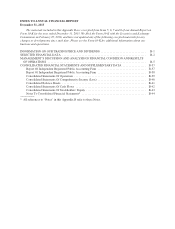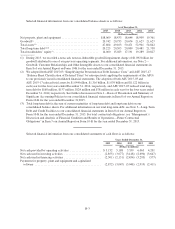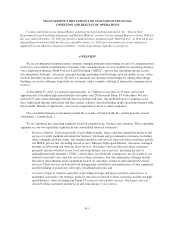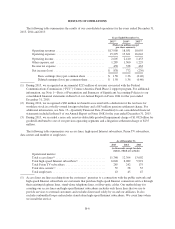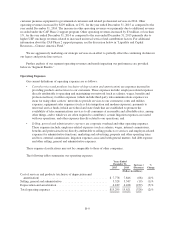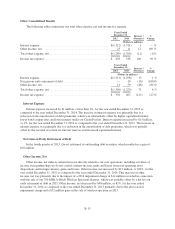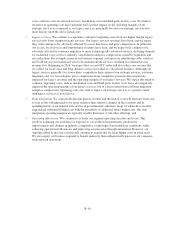CenturyLink 2015 Annual Report Download - page 115
Download and view the complete annual report
Please find page 115 of the 2015 CenturyLink annual report below. You can navigate through the pages in the report by either clicking on the pages listed below, or by using the keyword search tool below to find specific information within the annual report.(2) We define a data center as any facility where we market, sell and deliver either colocation services, multi-
tenant managed services, or both. Our data centers are located in North America, Europe and Asia.
During the last decade, we have experienced revenue declines primarily due to declines in access lines,
private line customers, switched access rates and minutes of use. To mitigate these revenue declines, we remain
focused on efforts to, among other things:
• promote long-term relationships with our customers through bundling of integrated services;
• provide a wide array of diverse services, including enhanced or additional services that may become
available in the future due to, among other things, advances in technology or improvements in our
infrastructure;
• provide our high-speed Internet and premium services to a higher percentage of our customers;
• pursue acquisitions of additional assets if available at attractive prices;
• increase prices on our products and services if and when practicable;
• increase the capacity and speed of our networks;
• increase usage of our networks; and
• market our products and services to new customers.
Operating Revenues
We currently categorize our products, services and revenues among the following four categories:
•Strategic services, which include primarily high-speed Internet, MPLS (which is a data networking
technology that can deliver the quality of service required to support real-time voice and video), private
line (including special access), Ethernet, colocation, hosting (including cloud hosting and managed
hosting), video (including our facilities-based video services, which we now offer in 16 markets), VoIP
and Verizon Wireless services;
•Legacy services, which include primarily local and long-distance voice services, including the sale of
UNEs, switched access, and Integrated Services Digital Network (“ISDN”) services (which use regular
telephone lines to support voice, video and data applications);
•Data integration, which includes the sale of telecommunications equipment located on customers’
premises and related professional services, such as network management, installation and maintenance
of data equipment and building of proprietary fiber-optic broadband networks for our business
customers; and
•Other operating revenues, which consists primarily of Connect America Fund (“CAF”) support
payments, Universal Service Fund (“USF”) support payments and USF surcharges. We receive federal
support payments from both CAF Phase 1 and CAF Phase 2 programs, and support payments from
both federal and state USF programs. These support payments are government subsidies designed to
reimburse us for various costs related to certain telecommunications services, including the costs of
deploying, maintaining and operating voice and high-speed Internet infrastructure in high-cost rural
areas where we are not able to recover our costs from our customers. USF surcharges are the amounts
we collect based on specific items we list on our customers’ invoices to fund the Federal
Communications Commission’s (“FCC”) universal service programs. We also generate other operating
revenues from leasing and subleasing of space in our office buildings, warehouses and other properties.
Because we centrally manage the activities that generate these other operating revenues, these revenues
are not included in our segment revenues.
B-7





